What can you say…… it seems the Empire is striking back. Or maybe Neptune is reminding us of the devastation we are causing to sea habitats – ironic that one of the worst culprits, continually laughing in the face of International agreements to limit the catching of Whales and Blue Tuna, is now itself flattened by the sea, its Suishi habit forcefully withdrawn, for a long while anyway.
Here in Wales, unbelievably no doubt, there are still farms that are not allowed to sell their sheep because of radiation in the ground as a result of Chernobyl. What will be the long term legacy of what is now unfolding in the land of the Rising Sun.
I feel battered and drained by the constant emotional attacks of continuing ‘natural disasters’. Who doesn’t view these dreadful events and consider what would they do or feel like if they had suffered such loss. On top of that we have political turmoil in a very dangerous part of the world where the major powers seem impotent to help the ‘freedom fighters’.
The fortunate circumstances of my life – my family, my country and my peace – is a cause for thanks but also for guilt. Writing about life in the hills and vales of Wales is again a matter of some embarrassment to me, so feel free to ignore me this week, you too must be wondering what is the priority for all of us just now.
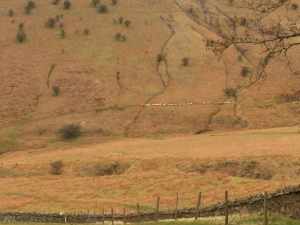
These are my mountains and this is my vale - for the next few weeks anyway; a welcome retreat from constant bad news.
I’m back on the slopes of the upper Rhiangoll valley in the Black Mountain range of the eastern Brecon Beacons. This is my third stint on this farm, rebuilding the mid C18th mountain wall as part of the Tir Gofal ‘all farm agri-environment scheme. Sadly it is the very last piece of walling I will do under the old grant scheme. The farm is situated in a very ancient countryside, indeed its land once formed a part of a Norman hunting forest (Cwm Fforest in Welsh). By the 1400s, maybe a century earlier, the land began to be leased out to farmers- often unbeknown to His Majesty – by the local Lord, in this case the Lord of Talgarth.
The valley of the Rhiangoll is a steep sided incision into the hills which form the high remote Black Mountains. The small river flows west/south-west to join the larger river Usk outside Crickhowell. The mouth of the valley is dominated by two significant historic features, firstly the Roman camp near Cwmdu which marks the route of the military road from Abergavenny to Brecon and secondly the fortified manor house of Tre-tower (w Tre-twr). The Roman camp is due to undergo an archaeological excavation this summer and the actual route of the road to Talgarth may be revealed. The suggested route, up the Rhiangoll valley (Henffordd – the old road) and through the pass at Pengenffordd (top of the old road) and thence to Talgarth and on to the Wye valley and the important Roman iron foundry at Gwernyfed, is conjectural at present, unlikely in my view. Unlikely because at the head of the valley, dominating the pass, is the multi-valleted Iron-age defended enclosure of the Dinas. (Dinas is the Welsh name for a defended hill-fort and often appended to such forts throughout Wales).
However, long before the tribal settlements of the Iron Age, this land was occupied and stone cairns built by Bronze-age farmers dominate the ridge-line of Mynydd Troed and Mynydd Llangorse, between the valley and the basin of the lake (Llangorse). Of even more significance is the Neolithic long chambered burial mound of Ty Isaf which is set – as are all Cotswold-Severn type stone built chambered tombs – not on the sky-line but just below, visible only from below to those communities who lived and farmed in its shadow.
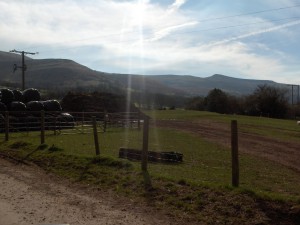
We don't get too 'precious' about our 4000 year old relics here in Wales. The lumps and bumps in the grass is the Neolithic chambered tomb of Ty Isaf, the big mound is manure, the black round bales is silage. The farmer was telling me how coach loads of students and amateur archaeologists used to flock to the site....... he found a way of deterring them ! Every evening his six sheep dogs lie out on the mounds of the tombs and, so he tells me, always have done - he thinks it's simply because there is a good view from there....mmm, what do you think ?
I nonchalantly drive past this old revered site each morning and evening and always chuckle at the irreverence with which the farmer treats this ‘holy’ site of Ancestors from four thousand or so years ago. There is always a large ‘midden’ (manure heap) and stacks of black plastic covered silage bales. Most visitors have no idea it is there, indeed few locals know what it is. I love the fact that his farm dogs always choose that site to lie out and await their next job – his son, who passes me often on my wall site, told me they go there when the ‘old man’ goes off somewhere and await his return – surely they ‘feel’ some calming energy emanating from within ?
High above the burial chamber looms the cone shaped hill fort of the Dinas. Its multi-valleted ramparts (more than one ditch and bank) protect a large flat inner area which was subsequently – around 1350 BC – the home of a large Norman castle of which little remains but a few stone walls.
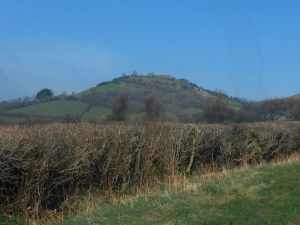
This insignificant looking hill bears the scars of multiple ditches and banks which denote the defences of the Iron-Age fortress. Below and in front is the Neolithic burial chamber. An ancient landscape indeed.
So for now and each day for the next few weeks I dwell in a landscape which holds six thousand years of history. This kind of palimpsest is not unique in this part of Wales, my next site, at Llangorse, is equally significant. The current wall I am rebuilding is at the other end of the historical spectrum. It was built in the mid C18th to enclose an extra line of fields higher up the hill than had been previously possible. Partly this was due to the ending of the ‘Little Ice Age’ which allowed pasture and arable to be viable at a higher altitude and partly it was due to the improvements brought about by the Agricultural Revolution which saw root crops providing winter fodder that allowed sheep numbers to increase and cattle to be kept.
The farm was first a part of the great Beaufort estate which owned (and still owns) land throughout the Principality. The lineage of the Dukes of Beaufort is distinguished and long and takes the history of the estate back to the centuries immediately after the Norman invasion. Later the area of the Rhiangoll valley passed to the Glan Usk estate – again still a large estate in the area – and it was the improvements of the MacNamarras which resulted in the expansion up the slopes.
During the period of the C13th/C14th when the Fforest – an area reserved for hunting by Royalty and/or assigned Noblemen (and not necessarily an area of wooded countryside) – began to be more used for cattle rearing, albeit on a small scale, another historic element of the current landscape was created. It is not widely known that a system of farming familiar in the Alps was also once common in the Welsh uplands. Most early farms were small and the fields were small and valuable. In order to be able to grow arable crops and allow meadows to grow hay through the spring and summer months the livestock needed to be kept off the fields. One way of solving the problem was to utilise the vast open Mynydd, the mountain grazing. Before the coming of sheep as the common hill stock small herds of cattle, usually diary and calves, were taken to the hill during the period from May until late September. They were looked after by members of the farmer’s family – perhaps the younger son – and women were also there on the upland ‘shielings’ to assist with the processing of dairy products. The movement from the Home farm or ‘old home (w. Hendre) involved droving the cattle up to 8 miles or so ( a day’s walk was the normal distance) to an area of land to which the family had ‘rights’ . A small corral was constructed to keep the cattle safe at night – in a period when wolves still roamed the Welsh hills as well as bandits – this consisted of a dry stone walled enclosure with good access to a mountain stream. For the family members assigned to look after the cattle a small simple dwelling was constructed. This was normally a rectangular structure of low stone walls and ‘A’ frame timbers to form the roof which was covered with ‘ling’ – heather – or rush.
When I first arrived at the ‘Grafog’ (meaning ‘Garlic’ and probably referring to wild garlic / ransome which was growing in the wooded valley) and discovered a small sheep fold associated with a stream-side wash, the farmer told me of another fold, the ‘Mint’ fold, which was further up the valley, some 500 metres beyond the mountain wall. When eventually I walked up to find it I found a most remarkable ‘corral’ (not in fact a sheep fold at all). Knowing that there ought therefore to be a small house nearby I searched the obvious potential sites – the house was normally situated on a south facing platform preferably between two small streams – until I found what I wanted. There, in the bracken, was a rectangular low walled building, the door set in the southern gable and the walls no more than 2 ft high. It sat between the two streams and was hitherto unknown. Even the farmer did not know of it, other than there was a pile of stones in the bracken. This summer dwelling was called a Hafod or Lluest (summer dairy) and after the Acts of Union in the C16th when the old Welsh tradition of partible inheritance (division of the home farm between the sons on the death of the father) was changed to primogeniture (eldest son inheriting) these upland hafods/lluests were often made permanent farms occupied all year with small fields being created out on the open hill. Such names are still locked into the present day place-names of upland farms.
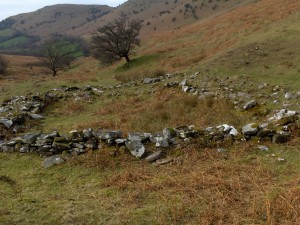
This is the 'Mint Fold' as it is locally known, but it is in fact a corral for penning cattle which were brought to the upland pastures in the summer. It is approximately 30 metres along each side.
So, here I am, not only working in an ancient landscape but contributing to the understanding of the continued occupation of this seemingly remote area in the medieval period.
My rebuilding of the mountain boundary wall is preserving yet another layer of history. The dry stone wall is built of Old Red Sandstone, that ideal sandstone which occurs throughout the Brecon Beacons National Park and presents in flat surfaced slabs which allows for easy building.
The wall has stood well for over 200 years but the continual attack on its structure, primarily by heavy snow drifts and frost damage to the stones themselves, means that it is not possible to merely ‘make-do and mend’. It has been necessary to dismantle the whole wall (where this dilapidation has occurred) and rebuild it from new.
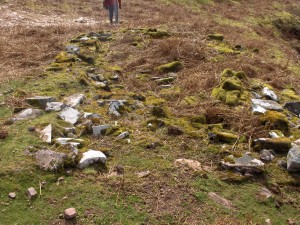
Here the outline of the Medieval dwelling, the Hafod, can be clearly seen in the dead bracken. The corners are still intact and the doorway can be discerned facing the morning sun. It is 30 ft (10 m x 4m) by 12 ft. I will one day carry out a full archaeological dig and I want to reconstruct the walls of both structures to get a clear understanding of how high they originally stood.
The first job is to carefully take down the existing structure which can be a delicate matter as a derelict wall can often suddenly collapse. The stones are sorted as they are taken off so that the correct sized stones are available in order during the reconstruction.
The rebuild is funded under a farm environmental scheme called Tir Gofal which grant aids the farmer (to approx 50% of total cost) for undertaking such work along with hedge-row restoration, management of fertiliser inputs, new gates and fencing and a number of other items.
Once completed the newly restored wall should remain for another 200 years and more; who will next take it down and restore it I wonder !
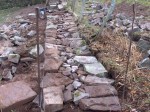
The foundation is laid, the biggest stones are set on the surface not into a deep trench, this is to allow water to pass through the base and not cause subsidence.
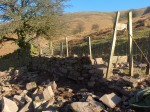
And when you are only half way up, you are neither up or down ! Day one of the rebuild should see you half way back up - the length of the section - called the 'stint' - is traditionally a 'Rood' being 6 yards in Wales - 7 yards in Scotland.
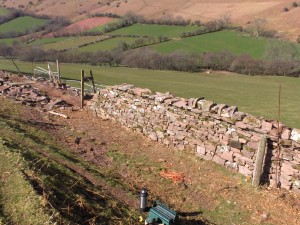
3 days later it should look like this...... Notice the small 'shelf' like stones that stick out beyond the line of the wall near the top, this is the 'cover band' which forms a reasonably water-tight cover to the top of the wall, on top of the cover band comes the cope stones.
It is a strange feeling to be the first to handle stones since the man who put them there so long ago. The magnitude of the effort to both build the wall and access and move to the site the thousands of tons of stone seems never to be considered by those who pass by on their pleasant mountain walks. I feel quite honoured to be able to ‘do’ this job, although I’m not the only person to have contributed to the restoration of this landscape. Two other dry stone wallers were employed prior to me, one of them a very good young waller who has now turned to gamekeeping – sadly in one way for we need youngsters to take up the mantle of country craftsmen.
I often wonder what it is that enables one person to grasp the idea of how one stone fits onto another. It is surely some innate aptitude, something that maybe all crafts-people and artists have; a way of seeing shapes and dimensions in a space blanked out from other’s view. One other person has helped me to rebuild this important little part of the historic Welsh landscape. She was /is an accomplished baker – a superb artist in the field of food – and yet the mystery of how a wall stands with just the skill of the person who places the stones was as nothing to her. Almost instinctively she was, firstly, drawn to the craft and, secondly, able to build a wall with little or no instruction. Similarly she turned her hand to forging and shaping metal. Her section of this wall stands indiscernible from mine or the other wallers, and yet our cake baking abilities are not so readily called forth ! I can offer no explanation other than that within every crafts-person, artist, artisan, there is some part of the brain that is wired differently, some part of the soul that retains a primeval element, a longing to touch and work, shape and make, a strand of DNA that goes all the way back to those builders of the chambered burial tombs, the stone work within which is impeccable.
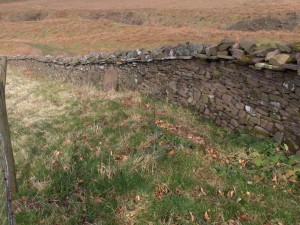
This section of the mountain wall was built by a 'Girl' !! Can you believe it.... it stands next to sections built by experienced and qualified Dry Stone Wallers, can you spot the difference? You won't if you go and stand next to it, it is high quality craftsmanship. No more and no less than was evident in all other areas of craft that she demonstrated. What is that innate quality that separates those that 'can' from those that 'can't' ? It is beyond my comprehension.
So, the history of the Rhiangoll valley, its famous Neolithic burial chamber, the Bronze-Age cairns marking the skyline graves of those who lived there some three thousand years ago, the impressive hill-fort of the Dinas, field systems and boundaries of the medieval, settlements of farmers who operated a system of transhumance, and a dry stone wall, first built in the middle of the eighteenth century, restored by a Welshman and a young lady from the Carolinas of the United States of America. The lead scroll which I leave in all my walls, telling who rebuilt the wall, when and for whom, how far and how much, tells the finder that in the autumn of 2009 that particular wall was built by Miss………..M.A. , a folklorist and baker from the town of Greenville SC. What on earth will they think !
As the increasingly demented World disturbs my equilibrium, I find being in this place and thinking of those thousands of years of history and people, of my legacy to it, of my dear PP who felt the same about this spiritual place, I can allow hope to arise in my pysche, but the whirling onward rush of our chaotic Planet makes me wish I could indeed, press the bell, stop it and get off at some tranquil Oasis, somewhere like the Rhiangoll valley, preferably with someone who can make a good cake !
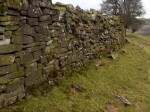
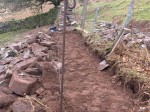
Leave a comment